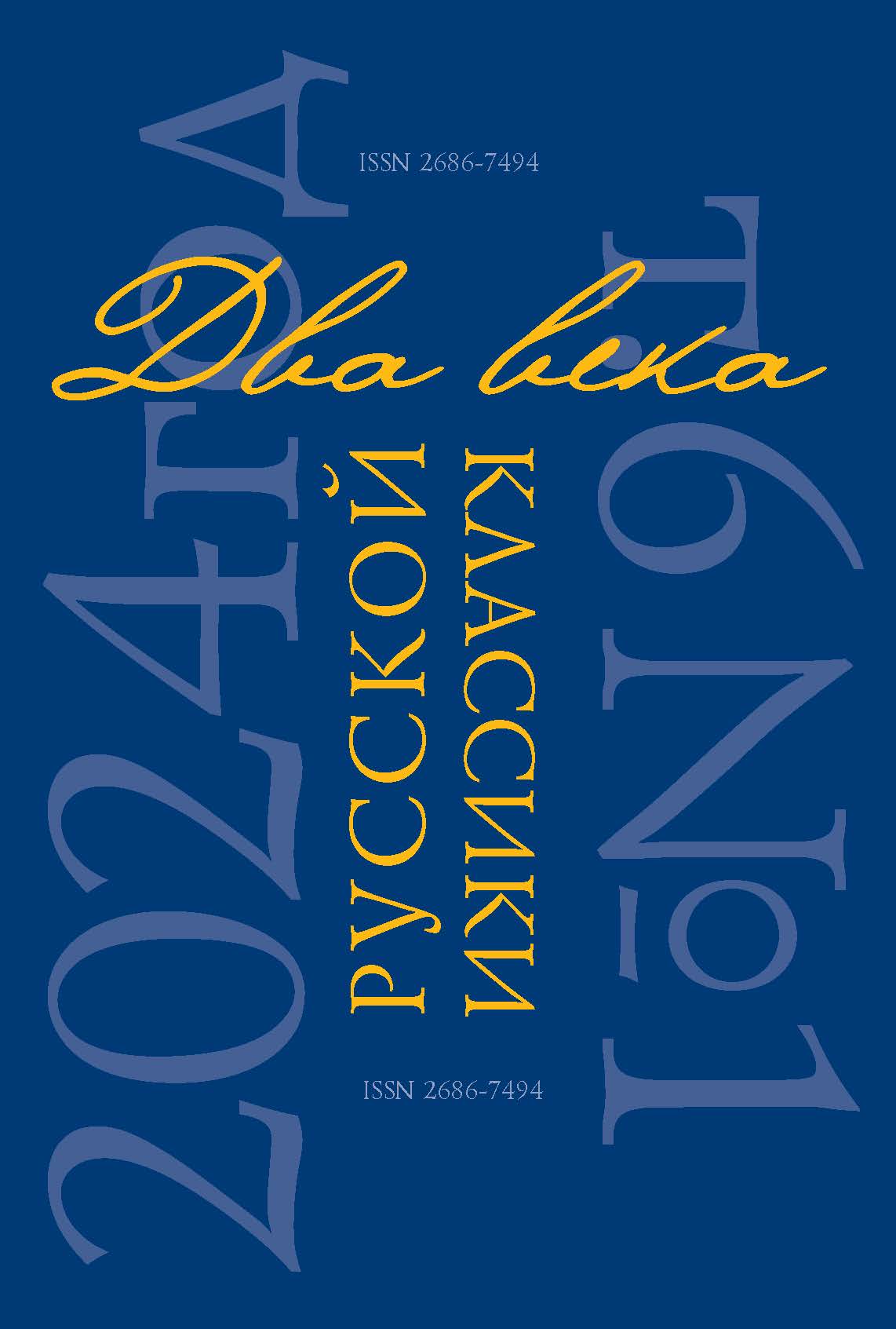Abstract:
The article deals with the art reviews of F. M. Dostoevsky. Based on the analysis of the articles “Exhibition at the Academy of Arts for 1860–61” and “About the Exhibition” published in “A Writer’s Diary” for 1873, the aesthetic criteria for Dostoevsky’s assessment of genre, historical, portrait and landscape Russian painting are determined. The author of the article reveals the most important criteria outlined by Dostoevsky: the expression of the author’s ideal that distinguishes a painting from mirror reflection and photography; the artist’s independence from direction, excessive naturalness, theatricality and “excessive showiness”. Particular attention is paid to Dostoevsky’s analysis of paintings by V. N. Jacobi, V. G. Perov, V. E. Makovsky, N. G. Sсhilder, M. P. Klodt, I. E. Repin, A. I. Kuindzhi, N. N. Ge, whose work aroused genuine interest of the writer and prompted reflections on artistic truth in art. The characters of the paintings as presented by Dostoevsky come to life, acquire a “history of feelings”, a psychological appearance and a voice. The work distinguishes between such concepts used by Dostoevsky to analyze contemporary painting for the writer in the light of “realism in the highest sense”, such as “natural truth”, “real truth”, “stage truth”, “artistic truth”, “higher truth”.
References
Akel’kina, E. A. “F. M. Dostoevskii khudozhestvennyi kritik (problema akademicheskoi traditsii v stat’e ‘Vystavka v Akademii khudozhestv za 1860–61 god’)” [“F. M. Dostoevsky Art Critic (the Problem of Academic Tradition in the Article ‘Exhibition at the Academy of Arts for 1860–61)”]. Vestnik Omskogo universiteta, no. 4, 2007, pp. 71–74. (In Russ.)
Borisova, V. V. “Intermedial’nost’ v ‘Dnevnike pisatelia’ F. M. Dostoevskogo” [“Intermediality in the ‘Diary of a Writer’ by F. M. Dostoevsky”]. Kul’tura i tekst, no. 1 (14), 2013, pp. 55–60. (In Russ.)
Vel’chak, D. “‘Sikstinskaia Madonna’, ‘Mertvyi Khrsitos’ i ikona Bogomateri: F. M. Dostoevskii o religioznoi zhivopisi i ikonopisi” [“‘Sistine Madonna’, ‘Dead Chrsitos’ and the Icon of the Mother of God: F. M. Dostoevsky on Religious Painting and Icon Painting”]. ART LOGOS, no. 1 (3), 2018, pp. 31–42. (In Russ.)
German, M. Iu. “Dostoevskii o zhivopisi i zhivopis’ Dostoevskogo” [“Dostoevsky about Painting and Painting of Dostoevsky”]. Dostoevskii i mirovaia kul’tura, no. 11, 1998, pp. 155–168. (In Russ.)
Kasatkina, T. A. “Dostoevskii, obraz mira i cheloveka: ikona i kartina” [“Dostoevsky, the Image of the World and Man: Icon and Painting”]. Sovremennye problemy izucheniia poetiki i biografii F.M. Dostoevskogo: Retseptsiia, variatsii, interpretatsii [Modern Problems of Studying Poetics and Biography of F. M. Dostoevsky: Reception, Variations, Interpretations]. St. Petersburg, Dmitrii Bulanin Publ., 2016, pp. 129–146. (In Russ.)
Kasatkina, T. A. Sviashchennoe v povsednevnom: Dvusostavnyi obraz v proizvedeniiakh F. M. Dostoevskogo [Sacred in Everyday Life: Two-part Image in the Works of F. M. Dostoevsky]. Moscow, IWL RAS Publ., 2015. 528 p. (In Russ.)
Kashina, N. V. Estetika F. M. Dostoevskogo [Aesthetics of F. M. Dostoevsky]. Moscow, Vysshaia shkola Publ., 1989. 286 p. (In Russ.)
Leniashin, V. A. “Peredvizhniki: pravda v krasote ili krasota v pravde” [“Wanderers: Truth in Beauty or Beauty in Truth”]. Nauchnye Trudy, no. 40, 2017, pp. 100–110. (In Russ.)
Matveeva, I. Iu. “‘Khristos v pustyne’ I. N. Kramskogo i novaia interpretatsiia obraza Iisusa Khrista v russkoi kul’ture vtoroi poloviny XIX veka” [“‘Christ in the Desert’ by I. N. Kramskoy and a New Interpretation of the Image of Jesus Christ in Russian Culture of the Second half of the 19th Century”]. Veche, no. 31, 2019, pp. 162–181. (In Russ.)
Millionshchikova, T. M. “Vizual’nye obrazy v proizvedeniiakh F. M. Dostoevskogo” [“Visual Images in the Works of F. M. Dostoevsky”]. Sotsial’nye i gumanitarnye nauki. Otechestvennaia i zarubezhnaia literatura. Seriia 7: Literaturovedenie, no. 4, 2018, pp. 154–160. (In Russ.)
Perlina, N. M. Teksty-kartiny i ekfrazisy v romane F. M. Dostoevskogo “Idiot”. [Textspictures and Ecphrases in the Novel by F. M. Dostoevsky “The Idiot”]. St. Petersburg, Aleteiia Publ., 2017. 288 p. (In Russ.)
Prokhorov, G. S. “Povestvovatel’naia struktura ‘Dnevnika pisatelia’ F. M. Dostoevskogo (postanovka voprosa)” [“The Narrative Structure of Dostoevsky’s ‘Diary of a Writer’ (Posing the Question)”]. Novyi filologicheskii vestnik, no. 4 (15), 2010, pp. 5–14. (In Russ.)
Sedel’nikova, O. V. “Poetika vizualizatsii v romane Dostoevskogo ‘Prestuplenie i nakazanie’.” [“Poetics of Visualization in Dostoevsky’s Novel ‘Crime and Punishment’.”]. Sovremennye problemy izucheniia poetiki i biografii Dostoevskogo: Retseptsiia, variatsii, interpretatsii. [Modern Problems of Studying Poetics and Biography of F. M. Dostoevsky: Reception, Variations, Interpretations]. St. Petersburg, Dmitrii Bulanin Publ., 2016, pp. 288–303. (In Russ.)
Stepanova, E. V. “Zhurnal’nye retsenzii F. M. Dostoevskogo o razvitii russkogo izobrazitel’nogo iskusstva” [“Journal Reviews of F. M. Dostoevsky on the Development of Russian Fine Art”]. Ekonomika i obshchestvo v fokuse sovremennykh issledovanii: traditsii i innovatsii [Economy and Society in the Focus of Modern Research: Traditions and Innovations]. Saratov, Institut issledovanii i razvitiia professional’nykh kompetentsii Publ., 2015, pp. 137–140. (In Russ.)
Faustov, A. A. “Otsrochennoe budushchee: dve kartiny v pereskaze F. M. Dostoevskogo” [“Delayed Future: Two Pictures in the Retelling of F. M. Dostoevsky”]. Vestnik Voronezhskogo gosudarstvennogo universiteta. Seriia: Filologiia. Zhurnalistika, no. 3, 2021, pp. 18–23. (In Russ.)
Fridlender, G. M. “Estetika Dostoevskogo” [“Dostoevsky’s Aesthetics”]. Dostoevskii — khudozhnik i myslitel’ [Dostoevsky — Artist and Thinker]. Moscow, Khudozhestvennaya literatura Publ., 1972. 687 p. (In Russ.)
Perlina, N. “Portrayals of Aglaya and Nastasia: Ekphrastic narrative in ‘The Idiot’.” Aspekty poetiki Dostoevskogo v kontekste literaturno-kul’turnykh dialogov [Aspects of Dostoevsky’s Poetics in the Context of Literary and Cultural Dialogues]. St. Petersburg, Dmitrii Bulanin Publ., 2011, pp. 32–49. (In English)
Stempczynska, Barbara. Dostojewski a malarstwo [Dostoevsky and Painting]. Katowice, Uniwersytet Śląski, 1980. 143 p. (In Polish)









